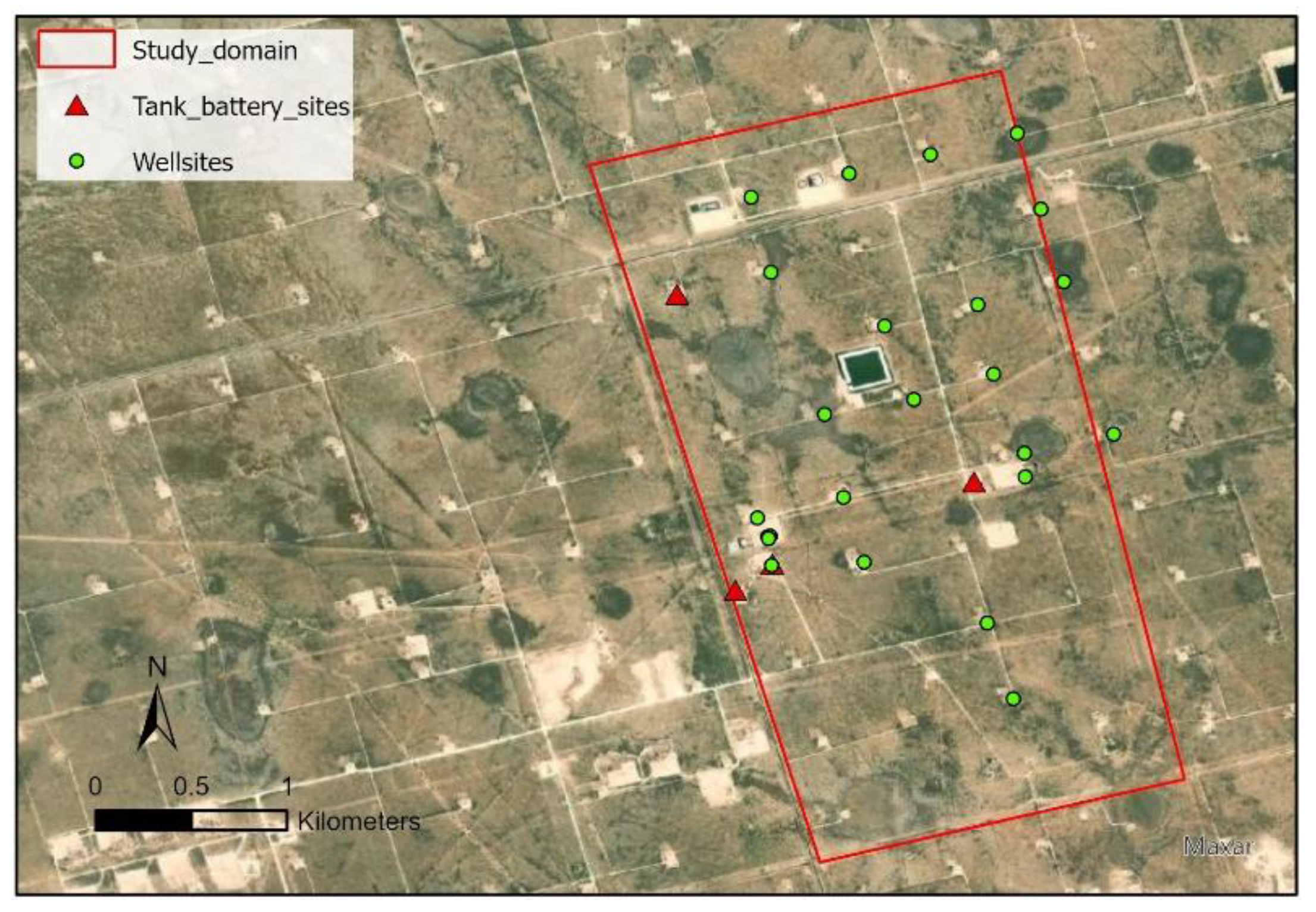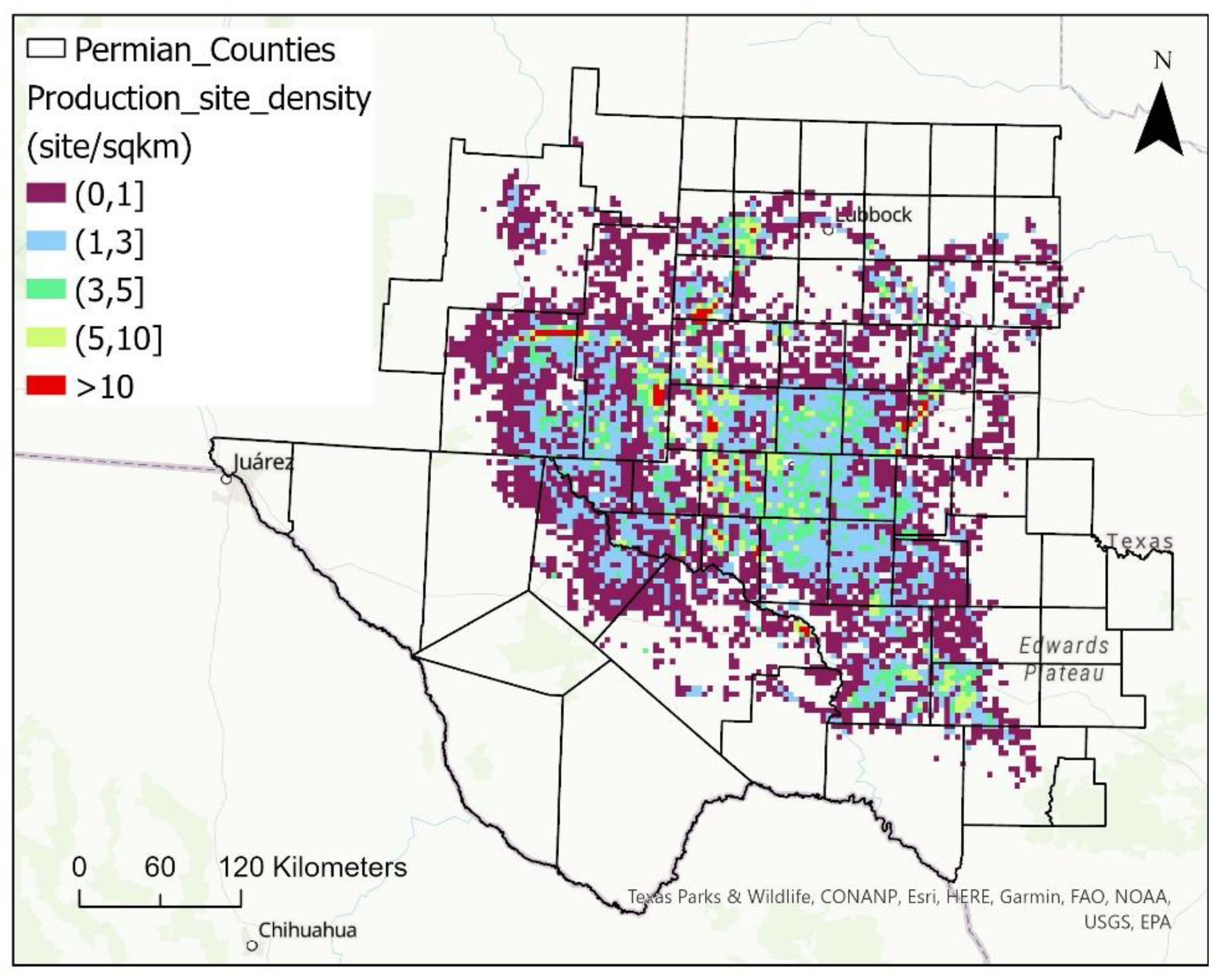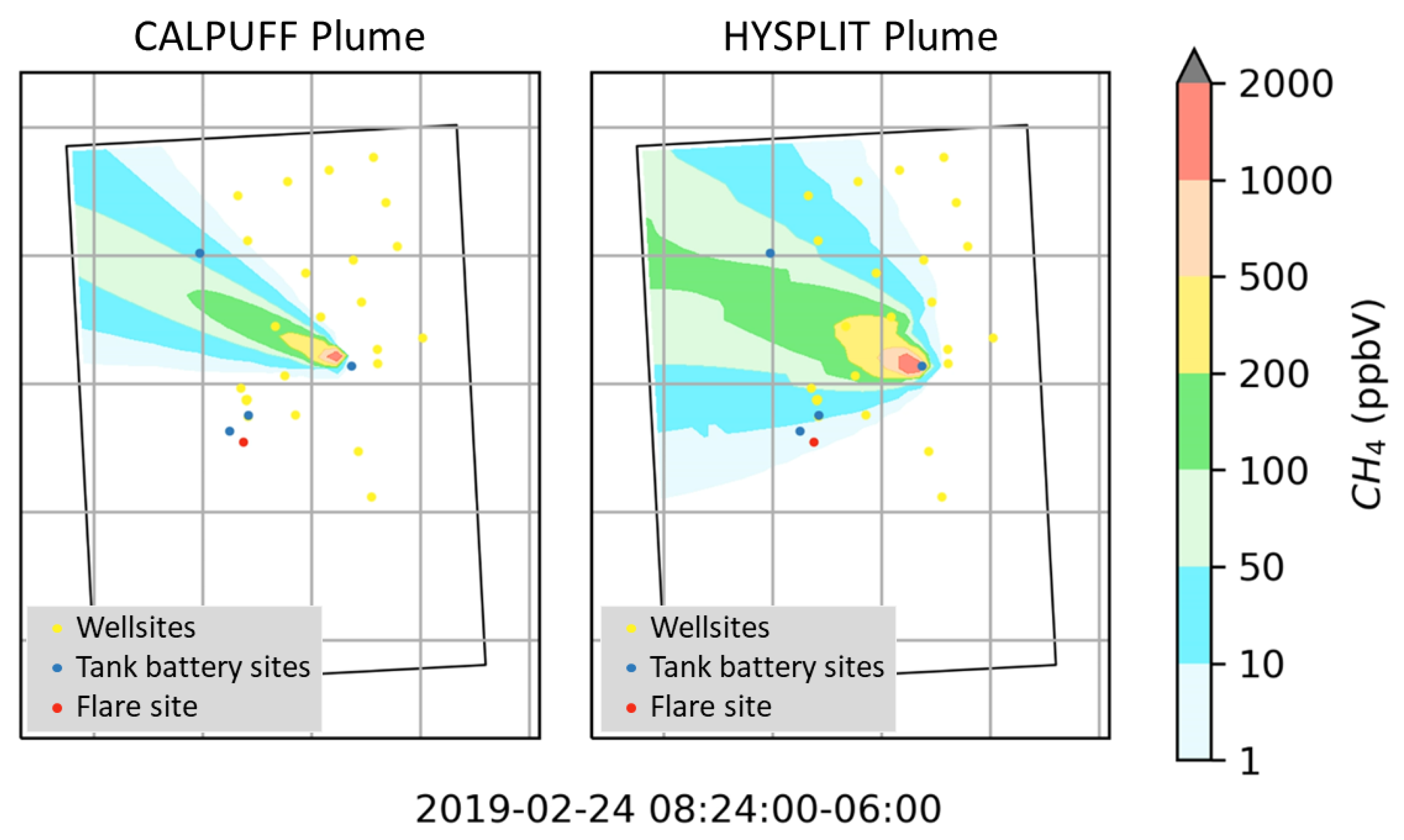Simulated Methane Emission Detection Capabilities of Continuous Monitoring Networks in an Oil and Gas Production Region
Abstract
:1. Introduction
2. Materials and Methods
2.1. Modeled Domain
2.2. Emission Detection
2.3. Emissions and Sensor Placement
2.4. Meteorological Episode Selection
2.5. Dispersion Modeling
3. Results
3.1. Base Case
3.2. Sensitivity Analyses
4. Discussion
5. Conclusions
Supplementary Materials
Author Contributions
Funding
Institutional Review Board Statement
Informed Consent Statement
Data Availability Statement
Acknowledgments
Conflicts of Interest
References
- Methane Guiding Principles, Reducing Methane Emissions Best Practice Guide: Identification, Detection, Measurement and Quantification. September 2020. Available online: https://methaneguidingprinciples.org/wp-content/uploads/2020/09/Reducing-Methane-Emissions_Identification-Detection-Measurement-and-Quantification_Guide.pdf (accessed on 10 August 2021).
- State of Colorado. Senate Bill 19-181. Available online: https://leg.colorado.gov/sites/default/files/2019a_181_signed.pdf (accessed on 10 August 2021).
- U.S. Environmental Protection Agency (EPA). Standards of Performance for New, Reconstructed, and Modified Sources and Emissions Guidelines for Existing Sources: Oil and Natural Gas Sector Climate Review. 2021. Available online: https://www.federalregister.gov/documents/2021/11/15/2021-24202/standards-of-performance-for-new-reconstructed-and-modified-sources-and-emissions-guidelines-for (accessed on 15 November 2021).
- Texas Railroad Commission (TRRC). Permian Basin Information (Website). 2020. Available online: https://www.rrc.state.tx.us/oil-gas/major-oil-and-gas-formations/permian-basin-information (accessed on 10 August 2021).
- Zhang, Y.; Gautam, R.; Pandey, S.; Omara, M.; Maasakkers, J.D.; Sadavarte, P.; Lyon, D.; Nesser, H.; Sulprizio, M.P.; Varon, D.J.; et al. Quantifying methane emissions from the largest oil-producing basin in the United States from space. Sci. Adv. 2020, 6, eaaz5120. [Google Scholar] [CrossRef] [PubMed] [Green Version]
- Zavala-Araiza, D.; Alvarez, R.A.; Lyon, D.R.; Allen, D.T.; Marchese, A.J.; Zimmerle, D.J.; Hamburg, S.P. Abnormal process conditions required to explain emissions from natural gas production sites. Nat. Commun. 2017, 8, 14012. [Google Scholar] [CrossRef] [PubMed] [Green Version]
- Fox, T.A.; Barchyn, T.E.; Risk, D.; Ravikumar, A.P.; Hugenholtz, C.H. A review of close-range and screening technologies for mitigating fugitive methane emissions in upstream oil and gas. Environ. Res. Lett. 2019, 14, 053002. [Google Scholar] [CrossRef]
- Methane Sensor Intercomparison. Available online: http://dept.ceer.utexas.edu/ceer/astra/showdown/showdown.cfm (accessed on 10 August 2021).
- Texas Commission on Environmental Quality (TCEQ). CAMS 47 Site. 2021. Available online: https://www.tceq.texas.gov/cgi-bin/compliance/monops/site_photo.pl?cams=47 (accessed on 28 November 2020).
- Stein, A.F.; Draxler, R.R.; Rolph, G.D.; Stunder, B.J.B.; MCohen, D.; Ngan, F. NOAA’s hysplit atmospheric transport and dispersion modeling system. Bull. Am. Meteorol. Soc. 2015, 96, 2059–2077. [Google Scholar] [CrossRef]
- Exponent. Official CALPUFF Modeling System. 2014. Available online: http://www.src.com/ (accessed on 1 December 2020).
- North American Mesoscale Forecast System (NAM). National Centers for Environmental Information (NCEI). 2021. Available online: https://www.ncdc.noaa.gov/data-access/model-data/model-datasets/north-american-mesoscale-forecast-system-nam (accessed on 1 December 2020).
- IHS Markit Enerdeq Browser (Licensed). Production Allocated, Permian Basin. Monthly Production Data in November 2021. Available online: https://my.ihs.com/energy (accessed on 17 February 2022).




| Sensor Precision (ppb) | Minimum Number of the 24 Available Sensors Required to Detect Continuous Emissions from 26 Sources in Each of the 4 Week-Long Periods (104 Detections) | Minimum Number of the 24 Available Sensors Required to Detect Intermittent Emissions from 26 Sources in Each of the 4 Week-Long Periods (104 Detections) |
|---|---|---|
| Emission rate of 10 kg/h | ||
| 1000 | 15 | 24 sensors made 98 detections * |
| 500 | 7 | 15 |
| 200 | 4 | 8 |
| Emission rate of 5 kg/h | ||
| 1000 | 24 sensors made 103 detections * | 24 sensors made 93 detections * |
| 500 | 15 | 24 sensors made 98 detections * |
| 200 | 7 | 13 |
| Emission rate of 1 kg/h | ||
| 1000 | 24 sensors made 71 detections * | 21 sensors made 25 detections * |
| 500 | 24 sensors made 96 detections * | 24 sensors made 53 detections * |
| 200 | 24 sensors made 103 detections * | 24 sensors made 93 detections * |
| Sensor Precision (ppb) | Minimum Number of the 7 Available Sensors Required to Detect Continuous Emissions from 7 Sources in Each of the 4 Week-Long Periods (28 Sources) | Minimum Number of the 7 Available Sensors Required to Detect Intermittent Emissions from 7 Sources in Each of 4 Week-Long Periods (28 Sources) |
|---|---|---|
| Emission rate of 10 kg/h | ||
| 1000 | 7 | 7 sensors made 25 detections * |
| 500 | 5 | 7 |
| 200 | 3 | 6 |
| Emission rate of 5 kg/h | ||
| 1000 | 7 | 7 sensors made 22 detections * |
| 500 | 7 | 7 sensors made 25 detections * |
| 200 | 5 | 7 |
| Emission rate of 1 kg/h | ||
| 1000 | 7 sensors made 16 detections * | 5 sensors made 5 detections * |
| 500 | 7 sensors made 24 detections * | 6 sensors made 10 detections * |
| 200 | 7 | 7 sensors made 22 detections * |
| Sensor Precision (ppb) | Minimum Number of the 24 Available Sensors Required to Detect Continuous Emissions from 26 Sources in Each Week-Long Period | Minimum Number of the 24 Available Sensors Required to Detect Intermittent Emissions from 26 Sources in Each Week-Long Period |
|---|---|---|
| Winter (January/February/March meteorology) | ||
| Emission rate of 10 kg/h | ||
| 1000 | 4 | 11 |
| 500 | 2 | 7 |
| 200 | 1 | 4 |
| Emission rate of 5 kg/h | ||
| 1000 | 9 | 23 sensors made 25 detections * |
| 500 | 4 | 11 |
| 200 | 2 | 5 |
| Emission rate of 1 kg/h | ||
| 1000 | 20 sensors made 22 detections * | 3 sensors made 3 detections * |
| 500 | 15 | 14 sensors made 15 detections * |
| 200 | 9 | 23 sensors made 25 detections * |
| Spring (April/May/June meteorology) | ||
| Emission rate of 10 kg/h | ||
| 1000 | 4 | 16 |
| 500 | 2 | 10 |
| 200 | 1 | 6 |
| Emission rate of 5 kg/h | ||
| 1000 | 6 | 22 sensors made 23 detections * |
| 500 | 4 | 16 |
| 200 | 2 | 8 |
| Emission rate of 1 kg/h | ||
| 1000 | 12 sensors made 13 detections * | No detections |
| 500 | 22 sensors made 24 detections * | 7 sensors made 7 detections * |
| 200 | 6 | 22 sensors made 23 detections * |
| Summer (July/August/September meteorology) | ||
| Emission rate of 10 kg/h | ||
| 1000 | 15 | 20 sensors made 20 detections * |
| 500 | 7 | 13 |
| 200 | 4 | 8 |
| Emission rate of 5 kg/h | ||
| 1000 | 23 sensors made 25 detections * | 18 sensors made 19 detections * |
| 500 | 15 | 20 sensors made 20 detections * |
| 200 | 7 | 10 |
| Emission rate of 1 kg/h | ||
| 1000 | 9 sensors made 10 detections * | 1 sensor made 1 detection * |
| 500 | 20 sensors made 20 detections * | 6 sensors made 6 detections * |
| 200 | 23 sensors made 25 detections * | 18 sensors made 19 detections * |
| Fall (October/November/December meteorology) | ||
| Emission rate of 10 kg/h | ||
| 1000 | 2 | 7 |
| 500 | 2 | 5 |
| 200 | 1 | 3 |
| Emission rate of 5 kg/h | ||
| 1000 | 5 | 11 |
| 500 | 2 | 7 |
| 200 | 2 | 4 |
| Emission rate of 1 kg/h | ||
| 1000 | 15 | 21 sensors made 21 detections * |
| 500 | 7 | 24 sensors made 25 detections * |
| 200 | 5 | 11 |
| Sensor Precision (ppb) | Minimum Number of the 7 Available Sensors Required to Detect Continuous Emissions from 7 Sources in Each Week-Long Period | Minimum Number of the 7 Available Sensors Required to Detect Intermittent Emissions from 7 Sources in Each Week-Long Period |
|---|---|---|
| Winter (January/February/March meteorology) | ||
| Emission rate of 10 kg/h | ||
| 1000 | 4 | 6 |
| 500 | 2 | 5 |
| 200 | 1 | 4 |
| Emission rate of 5 kg/h | ||
| 1000 | 6 | 5 sensors made 5 detections * |
| 500 | 4 | 6 |
| 200 | 2 | 5 |
| Emission rate of 1 kg/h | ||
| 1000 | 5 sensors made 5 detections * | No detection |
| 500 | 6 | 2 sensors made 2 detections * |
| 200 | 6 | 5 sensors made 5 detections * |
| Spring (April/May/June meteorology) | ||
| Emission rate of 10 kg/h | ||
| 1000 | 3 | 7 |
| 500 | 2 | 6 |
| 200 | 1 | 5 |
| Emission rate of 5 kg/h | ||
| 1000 | 4 | 6 sensors detect 6 detections * |
| 500 | 3 | 7 |
| 200 | 2 | 6 |
| Emission rate of 1 kg/h | ||
| 1000 | 2 sensors made 2 detections * | No detection |
| 500 | 6 sensors made 6 detections * | 1 sensor made 1 source * |
| 200 | 4 | 6 sensors made 6 detections * |
| Summer (July/August/September meteorology) | ||
| Emission rate of 10 kg/h | ||
| 1000 | 7 | 4 sensors made 4 detections * |
| 500 | 5 | 6 |
| 200 | 3 | 6 |
| Emission rate of 5 kg/h | ||
| 1000 | 7 | 4 sensors made 4 detections * |
| 500 | 7 | 4 sensors made 4 detections * |
| 200 | 5 | 6 |
| Emission rate of 1 kg/h | ||
| 1000 | 2 sensors made 2 detections * | No detection |
| 500 | 4 sensors made 4 detections * | 1 sensor made 1 detection * |
| 200 | 7 | 4 sensors made 4 detections * |
| Fall (October/November/December meteorology) | ||
| Emission rate of 10 kg/h | ||
| 1000 | 3 | 6 |
| 500 | 2 | 6 |
| 200 | 1 | 2 |
| Emission rate of 5 kg/h | ||
| 1000 | 5 | 7 |
| 500 | 3 | 6 |
| 200 | 1 | 4 |
| Emission rate of 1 kg/h | ||
| 1000 | 7 | 5 sensors made 5 detections * |
| 500 | 7 | 6 sensors made 6 detections * |
| 200 | 5 | 7 |
Publisher’s Note: MDPI stays neutral with regard to jurisdictional claims in published maps and institutional affiliations. |
© 2022 by the authors. Licensee MDPI, Basel, Switzerland. This article is an open access article distributed under the terms and conditions of the Creative Commons Attribution (CC BY) license (https://creativecommons.org/licenses/by/4.0/).
Share and Cite
Chen, Q.; Modi, M.; McGaughey, G.; Kimura, Y.; McDonald-Buller, E.; Allen, D.T. Simulated Methane Emission Detection Capabilities of Continuous Monitoring Networks in an Oil and Gas Production Region. Atmosphere 2022, 13, 510. https://doi.org/10.3390/atmos13040510
Chen Q, Modi M, McGaughey G, Kimura Y, McDonald-Buller E, Allen DT. Simulated Methane Emission Detection Capabilities of Continuous Monitoring Networks in an Oil and Gas Production Region. Atmosphere. 2022; 13(4):510. https://doi.org/10.3390/atmos13040510
Chicago/Turabian StyleChen, Qining, Mrinali Modi, Gary McGaughey, Yosuke Kimura, Elena McDonald-Buller, and David T. Allen. 2022. "Simulated Methane Emission Detection Capabilities of Continuous Monitoring Networks in an Oil and Gas Production Region" Atmosphere 13, no. 4: 510. https://doi.org/10.3390/atmos13040510
APA StyleChen, Q., Modi, M., McGaughey, G., Kimura, Y., McDonald-Buller, E., & Allen, D. T. (2022). Simulated Methane Emission Detection Capabilities of Continuous Monitoring Networks in an Oil and Gas Production Region. Atmosphere, 13(4), 510. https://doi.org/10.3390/atmos13040510







